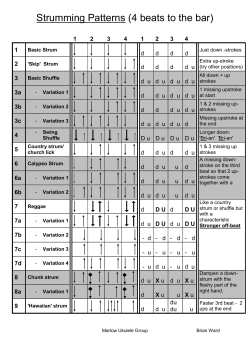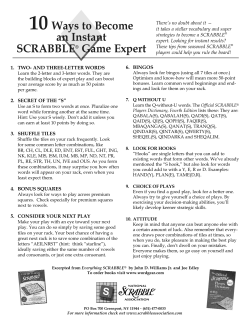
How to Encipher Messages on a Small Domain Ben Morris
How to Encipher Messages on a Small Domain
Deterministic Encryption and the Thorp Shuffle
Ben Morris
University of California, Davis
Dept of Mathematics
`
Phil Rogaway
Till Stegers
University of California, Davis
Dept of Computer Science
CRYPTO 2009 — August 18, 2009
1
How to encipher a CCN?
5887
3229
0447 4263
More generally,
How to encipher {0,1,…, N-1} ?
A special case of Format-Preserving Encryption (FPE)
[Brightwell, Smith 97;
Spies 08;
Bellare, Ristenpart, R, Steger 09]
PRF
PRP
F: K ´ {0,1}128 → {0,1}128
E: K ´ {0,1,…, N-1} → : {0,1,…, N-1}
2
Limitation
Known technique
• Balanced Feistel [Luby, Rackoff 88; Maurer, Pietrzak 03; Patarin 04]
Poor
proven bounds
• Benes construction [Aiello, Venkatesan 96; Patarin 08]
for small N
• Feistel adapted to Za ´ Zb [Black Rogaway 02]
• Induced ordering on AESK (0),…, AESK (N−1)
• “Knuth shuffle”
• Cycle walking [Folklore; Black Rogaway02]
Preprocessing
time Ω(N)
For enciphering on X ⊆ M when
|X | / |M| is reasonably large
• De novo constructions [Schroeppel 98]
Provable security
not possible
• Ad hoc modes [FIPS 74: 1981, Brightwell, Smith 97; Mattsson 09]
• Wide-block modes
[Naor, Reingold 99; Halevi 04]
• Granboulan-Pornin construction [GP 07]
Starts beyond
blockcipher’s blocksize
Very inefficient
3
What’s wrong with balanced Feistel?
N = 2n
In practice, probably nothing.
But, information theoretically,
n/2
it only tolerates 2
queries
Approximate security bounds
2n/4
[Luby, Rackoff 88]
(3 and 4 rounds)
[Maurer, Pietrzak 03]
(R rounds)
[Patarin 04]
2n/2
– 1/R
2n/2 – ε
(asymptotic)
Attacks
For constant rounds
2n/2
For R rounds
2n/2 + lg R
4
Encrypting by shuffling
0
1
2
3
4
5
6
7
8
9
1
0
1
1
1
2
0
1
2
3
4
5
6
7
8
9
10
11
12 13
1
3
1
4
1
5
14
15
[Naor ~1989] An oblivious shuffle: you can follow the path of a card without attending
to the other cards. The riffle shuffle is not oblivious. The Thorp shuffle is.
5
[Thorp 73]
Thorp Shuffle
Edward
Thorp
Th[N, R]
To shuffle a deck of N cards (N even):
For round r = 1, 2, …, R do
• Cut the deck exactly in half
• Using a fair coin toss c, drop
left-then-right (c=0) or right-then-left (c=1)
6
One round of the Thorp shuffle
1. Cards at positions
x and x + N/2 are
said to be adjacent
0 1 2 3
1
0
0
1
4
5 6 7
2. Flip a coin for each
pair of adjacent cards
3. The coins indicate
if adjacent cards get
moved
or
coin = 0
coin = 1
7
Thorp shuffle = maximally unbalanced Feistel
when N = 2n
At round r, move the card at position x ∈ {0,…, N-1} to position
2x
+
FK (r, x)
2(x− N/2) + (1 − FK (r, x− N/2))
if x < N/2
otherwise
equivalent
8
Measuring adversarial success
π (× )
EK (× )
A
E = Th[N, R]
EK−1(× )
π−1 (× )
strong PRP
cca
AdvN,R (q) =
max
−1
−1
E
E
Pr[A K K 1] – Pr[A π π 1]
max
Pr[A EK 1] – Pr[Aπ 1]
A ∈CCA(q)
nonadaptive PRP
ncpa
AdvN,R (q) =
A ∈NCPA(q)
9
What is Known?
For q = N,
if
ncpa
n
N=2
−r
AdvN,R (q) ≤ 2
R = O(r log 44 N) [Morris 05]
R = O(r log 19 N) [Montenegro, Tetali 06]
R = O(r log 4 N) [Morris 08]
If R = n,
cca
AdvN,R (q) ≤ (n+1)
(security to about N1/2 queries)
q2
N
[Naor, Reingold 99]
(throw in pairwise independent permutations, too)
10
Main result — Thorp shuffle — CCA
Theorem Let N = 2n and R=4nr (ie, 4r passes).
Adv
cca
Advantage
N, R
(q) ≤
2q
r+1
4qn r
N
r = 1, 2, 5, 10, 25
(4, 8, 20, 40, 100 passes)
Can tolerate
1− 1/r
q=N
queries with
4r passes.
Unbalanced Feistel
provably stronger
than balanced Feistel
N = 250
log2 (q)
11
Proving CCA security
1. Prove NCPA security of the “projected Thorp shuffle”
(and its inverse) using a coupling argument
2.
Conclude CCA security using a wonderful theorem from
[Maurer, Pietrzak, Renner 2007] :
Adv
cca
F°
G−1
cpa
(q) ≤ AdvF
cpa
(q) + AdvG (q)
12
Notation and basic setup
Fix distinct z1, …, zq ∈ C = {0,1}n and define:
Xt
Positions of cards z1, …, zq at time t
{ Xt }
Markov chain — the projected Thorp shuffle
Xt ( i )
Location of card zi at time t
τt
Distribution of {Xt}
π
Stationary distribution of { Xt }
= Uniform distribution on q-tuples of positions, {0,1}n
Want to show :
|| τt
− π || is small (for t not too big)
13
Hybrid argument
For 0 ≤ ` ≤ q, let
Xt` = Positions of cards z1, …, zq at time t assuming cards
z1, …, z` start in designated positions,
z`+1, …, zq start in random (uniform, distinct) positions
q
Xt
...
Xt`+1
Designated cards
have specified posns.
τt - distributed
|| τt
...
− π ||
≤
Σ
|| τt`+1 −
0
Xt
Designated cards have
random initial posns.
π-distributed
Fix `
q−1
Then
Xt`
τt` ||
`=0
14
[Doeblin 1930s; Aldous 1980s]
Coupling arguments
Markov chain { Wt } with transition matrix P
Stationary distribution π
Want to show || P t(x, × ) – π || is small
Construct a pair process , {(Wt , Ut)} (defined
on a single prob space), the coupling, where
{ Wt } and { Ut } are MCs with transition matrix P
If Wt = Ut then Wt+1 = Ut+1
W0 = x and U0 ~ π
Let T = min {t : Wt = Ut }
Coupling time
Then || P t(x, × ) – π || ≤ Pr ( Wt ≠ Ut)
= Pr (T > t)
15
What gets coupled
Fix `
First `+1 cards in
designated positions.
τt`+1 distributed
q
Xt
...
τt` distributed
Xt`+1
q−1
Then
|| τt
− π ||
First ` cards in
designated positions;
(`+1)st card at a
random position.
≤
Σ
Xt`
|| τt`+1 −
...
τt`
0
Xt
||
`=0
16
Towards defining our coupling
Re-conceptualizing how our MC evolves
0 1 2 3 4 5 6 7
1
0
0
1
1
0
0
0
0
1
1
1
coins are
associated with
positions
0 1 2 3 4 5 6 7
0
0
1
1
0
1
1
0
1
coins are
associated with
designated cards
Before: a coin c(r , x) for each
round r and position (x, x + N/2).
The coin determined if cards went
or
Now: a coin c(r, x) for each round r
and designated card x.
Update rule:
• Card zi adjacent to a non-designated
card: use its coin to decide if it
goes left (0) or right (1)
• Card zi adjacent to zj where i <j :
use the coin of zi to decide where
it goes … and so where zj goes, too.
17
Defining our coupling
z1
z2 . . . z`
z`+1
z1
z2 . . . z`
z`+1
c1
c2
c`+1
c1
c2
c`+1
c`
Xt`+1
`)
To define the pair process (X`+1
,
X
t
t
• Start cards z1, …, z` in the specified
locations for both Xt`+1 and Xt`
• Start card z`+1 at specified location in Xt`+1
• Start card z`+1 at uniform location in Xt`
• Evolve the process with the same coins
and the update rule
c`
Xt`
Then:
• Cards z1, …, z` follow the
same trajectory
• Once z`+1 and z`+1 match,
they stay the same
• Card z`+1 is uniform
18
st
Waiting for the (``+1)
z1
trajectory
z2
trajectory
cards to couple
z`
trajectory
z`+1
trajectory
19
After a “burn-in” period,
designated cards are rarely adjacent
Claim: For any pair of cards zi and zj and
any time t ≥ n − 1,
P(zi and zj are adjacent at time t) ≤ 1/ 2n −1
Reason: The only way for zi and zj to end
up adjacent at time t is if there were
consistent coin tosses in in each of
the prior n −1 steps.
The probability of this is 1/2n −1 .
20
The coupling bound
Want to show this is small. By coupling, it’s ≤ P(T > t)
where T is the coupling time
`+1 and X ` :
`+1
for
X
`
t
t
|| τt − π || ≤ Σ || τt − τt ||
`
`+1
T = min {t: P(Xt
= Xt ) }
Claim: P (T > 2n − 1) ≤ 2 × n × ` × (1 / 2n-1)
Cards z`+1 fail to converge only if
z`+1 is adjacent to some zi in Xt`+1 or
z`+1 is adjacent to some zi in Xt`
for some i ≤ `, in one of the last n time steps.
At most 2n` ways for this to happen. Just showed:
P(z`+1 and zi are adjacent at time t ≤ n+1) ≤ 1/ 2n −1
21
Concluding the result
P (T > 2n-1 ) ≤ 2 × n × ` × 21−n
r
P (T > r (2n-1) ) ≤ ( 2 × n × ` × 21−n )
so
q−1
|| τt − π || ≤
ncpa
Adv
N, R
(q)
Σ
`= 0
(n`22-n)r
≤
≤
(n22-n)r
q
r+1
q
∫0
x r dx
4qn r
N
22
Extensions and directions
• For a weaker security notion, DPA, two passes is enough.
• A simple trick lets you do 5 rounds per AES
• When N is not a power of 2, things get more complex
(in progress; constants increase)
• NIST submission (“FFX mode”) (with T. Spies) coming soon
• Coupling technique generally useful in cryptography.
Analyze other unbalanced Feistel schemes with V.T. Hoang.
• Open:
Tiny N ?
CCA security for 2 or 4 passes ?
Can perfect shuffling (à la [Granboulan, Pornin 07]) be practical?
23
Thorp shuffle — DPA security
Theorem Let N = 2n and R=2nr (ie, 2r passes).
dpa
Adv
Advantage
N, R
(q) ≤
4qn r
N
r = 1, 2
Asymptotically:
you can tolerate
1− ε
q=N
queries
with two rounds
N = 250
log2 (q)
24
The 5x speedup trick
25
© Copyright 2025














